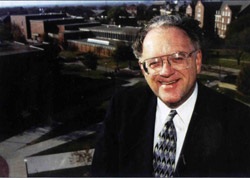
about the snack bar, soda fountain and coffee shop inside
the Commons Building that came to carry the name Alibi
Room, here shown filled to capacity in 1950.
It’s easy to take the Rhatigan Student Center for granted.
It’s not the best-looking building on campus (arguably the Frank Lloyd Wright-designed Corbin Education Center), nor the tallest (six-story Lindquist Hall).
Completed in 1959, it’s not venerable like clock-towered Morrison Hall, nor young and packed with techno-dazzle like the Marcus Welcome Center.
It’s not a place of learning per se, and Shocker championship bowling takes place in the basement, not in the round like Koch Arena’s fellow-winning Shockers.
But its purpose — to provide WSU students with a place on campus that isn’t school, a communal refuge of sorts — is as important today as when the RSC and its predecessors were first built.
Early Fairmount College had too few buildings to dedicate one solely to student social life, although organizations such as Men of Webster and Sorosis were provided club rooms in first Fairmount, then (after the former burned down) Jardine Hall.
The University of Wichita laid the foundation for many future campus gatherings and hijinks with the 1936 opening of the Auditorium and Commons Building (now Wilner Auditorium). The 1936 Parnassus hails “an auditorium which does not smell of gym socks and an eating place built to accommodate a mob.”
President Jardine also waxed enthusiastic, pointing out “(u)ntil we had the Commons there was no place on the campus for students to go when they had open hours between classes. … The Commons gives the students, as well as members of the faculty, and guests, a place to go for recreation, a place where they can be quiet, and can enjoy a peaceful atmosphere.”
Of course, not everyone wanted quiet! The most popular and beloved feature of the new Commons became the Alibi Room, a snack bar, soda fountain and coffee shop whose name was the result of a Student Council contest. During its first year, the Alibi served up more than 60 gallons of coffee a day, and more than a few ashtrays were filled by chatting coeds.
But within only a decade, 2,800-student WU and the Commons were stretched at the seams. In fall 1946, the Student Council (forerunner of the Student Government Association) started a campaign to build a proper student union.

emeritus dean of students (pictured above
with the Rhatigan Student Center in the
background), the RSC was first called the
Campus Activities Center. In fact, June 12
marked the 50th anniversary of its first
naming during a Student Union Planning
Committee meeting in 1956, when a group
of students, faculty and staff brainstormed
a name that would “stimulate new types of
experiences for students and faculty by
enriching the cultural life of the campus.”
For years, $3 was collected from each student every semester for the building fund; most of these students realized they were investing in a future long after they’d leave campus, but to many the legacy to the coming classes was worth it.
Their years of sacrifice led to the triumphant 1959 completion of the $1.85 million Campus Activities Center, with space for recreation, food service, a ballroom and a bookstore.
Wichita State University kept growing and, in 1968, the administration saw fit to double the size of the CAC, including the addition of a 500-seat theater.
For the first time, students could go to a movie on campus. First-run films were expensive to get in the ’70s, though, so the CAC Theater showed mostly black-and-white classics like Casablanca and Treasure of the Sierra Madre.
Today, the Rhatigan Student Center (renamed in 1997 for longtime dean and vice president for student affairs James Rhatigan) boasts — get ready now, this is quite a list: the Student Activities Council; the 14-time National Champion Shocker Bowlers; the Center for Student Leadership; Commerce Bank; Lords and Ladys [sic] Hair Salon; the Rec Center (billiards, bowling and yes, beer); the RSC Gallery, showcasing exclusively student work; the Shocker Card Center; the Student Government Association and Student Advocate; the University Bookstore; the University Information Center and University Reservations; WSU Campus Ministries; WSU Dining Services and Copperfield’s, a multi-restaurant food court with everything from takeaway sandwiches to international cuisine. It’s a hub of activity kept humming by director Bill Smith — since 1978! — and his dedicated staff.
But besides convenience, provisions and textbooks, the RSC — like the buildings that came before it — provides WSU’s diverse and scattered student body with a community focus, a place dedicated to their non-academic needs. A place to be Shockers simply — with something in common.





